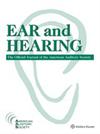Does Childhood Cochlear Implantation Spill Over to Carers' Employment Status?
IF 2.6
2区 医学
Q1 AUDIOLOGY & SPEECH-LANGUAGE PATHOLOGY
引用次数: 0
Abstract
OBJECTIVES Carers of children with disabilities, especially primary carers, tend to have poorer labor market outcomes than carers of typically developing children. However, the extant literature has been largely silent on whether interventions for children's disabilities spill over to carers' employment outcomes, if at all. We aimed to fill this gap. DESIGN We analyzed data from the Longitudinal Outcomes of Children with Hearing Impairment study, which is a unique panel dataset of Australian children who are deaf or hard-of-hearing (DHH). The Longitudinal Outcomes of Children with Hearing Impairment dataset includes information about 449 DHH children. We used 3 waves covering the same children at ages 0 to 3, 5 to 7, and 8 to 10 years during 2005 and 2018. We used a panel random-effects model, the use of which was supported by the Hausman specification test to control for time-invariant individual heterogeneity. RESULTS We found that primary carers (typically mothers) of DHH children with cochlear implants (CI) were more likely to be employed relative to DHH children without a CI. The positive association was stronger among carers from a lower socioeconomic background. CONCLUSIONS The association between childhood CI and carer employment may potentially be due to relaxed primary carers' time constraints to care for the child, increased self-efficacy, and reduced carer stress, enabling them to engage in other activities, including employment. Further research through large-scale, longitudinal studies is warranted to solidify the findings of this research.儿童人工耳蜗植入是否会影响照顾者的就业状况?
目的 残疾儿童的照护者,尤其是主要照护者,与发育正常儿童的照护者相比,在劳动力市场上的表现往往较差。然而,对于对残疾儿童的干预是否会影响到照护者的就业结果,现有文献基本上没有提及。设计我们分析了听力障碍儿童纵向结果研究(Longitudinal Outcomes of Children with Hearing Impairment study)的数据,这是一个独特的澳大利亚失聪或重听儿童(DHH)面板数据集。听力障碍儿童的纵向结果数据集包括 449 名 DHH 儿童的信息。我们在 2005 年和 2018 年期间使用了 3 个波次,涵盖了 0 至 3 岁、5 至 7 岁和 8 至 10 岁的相同儿童。我们使用了面板随机效应模型,该模型得到了豪斯曼规范检验的支持,以控制时间不变的个体异质性。结果我们发现,与没有植入人工耳蜗(CI)的 DHH 儿童相比,植入人工耳蜗(CI)的 DHH 儿童的主要照顾者(通常是母亲)更有可能就业。结论:儿童人工耳蜗与照护者就业之间的联系可能是由于主要照护者在照护儿童方面的时间限制减少、自我效能感提高以及照护者压力减轻,从而使他们能够从事包括就业在内的其他活动。我们有必要通过大规模的纵向研究开展进一步研究,以巩固本研究的结果。
本文章由计算机程序翻译,如有差异,请以英文原文为准。
求助全文
约1分钟内获得全文
求助全文
来源期刊

Ear and Hearing
医学-耳鼻喉科学
CiteScore
5.90
自引率
10.80%
发文量
207
审稿时长
6-12 weeks
期刊介绍:
From the basic science of hearing and balance disorders to auditory electrophysiology to amplification and the psychological factors of hearing loss, Ear and Hearing covers all aspects of auditory and vestibular disorders. This multidisciplinary journal consolidates the various factors that contribute to identification, remediation, and audiologic and vestibular rehabilitation. It is the one journal that serves the diverse interest of all members of this professional community -- otologists, audiologists, educators, and to those involved in the design, manufacture, and distribution of amplification systems. The original articles published in the journal focus on assessment, diagnosis, and management of auditory and vestibular disorders.
 求助内容:
求助内容: 应助结果提醒方式:
应助结果提醒方式:


